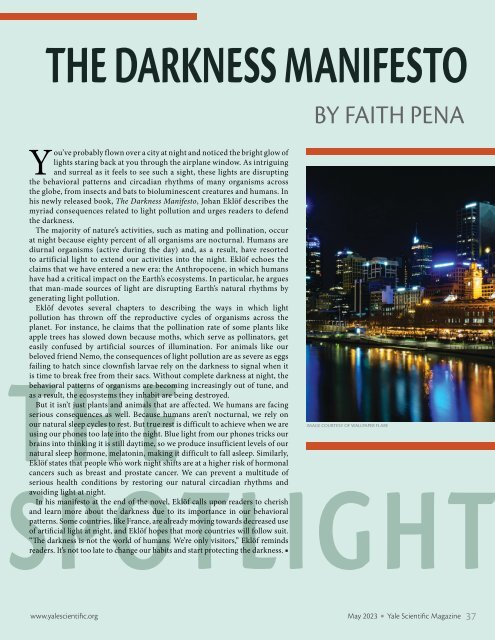YSM Issue 96.2
You also want an ePaper? Increase the reach of your titles
YUMPU automatically turns print PDFs into web optimized ePapers that Google loves.
THE DARKNESS MANIFESTO<br />
You’ve probably flown over a city at night and noticed the bright glow of<br />
lights staring back at you through the airplane window. As intriguing<br />
and surreal as it feels to see such a sight, these lights are disrupting<br />
the behavioral patterns and circadian rhythms of many organisms across<br />
the globe, from insects and bats to bioluminescent creatures and humans. In<br />
his newly released book, The Darkness Manifesto, Johan Eklöf describes the<br />
myriad consequences related to light pollution and urges readers to defend<br />
the darkness.<br />
The majority of nature’s activities, such as mating and pollination, occur<br />
at night because eighty percent of all organisms are nocturnal. Humans are<br />
diurnal organisms (active during the day) and, as a result, have resorted<br />
to artificial light to extend our activities into the night. Eklöf echoes the<br />
claims that we have entered a new era: the Anthropocene, in which humans<br />
have had a critical impact on the Earth’s ecosystems. In particular, he argues<br />
that man-made sources of light are disrupting Earth’s natural rhythms by<br />
generating light pollution.<br />
Eklöf devotes several chapters to describing the ways in which light<br />
pollution has thrown off the reproductive cycles of organisms across the<br />
planet. For instance, he claims that the pollination rate of some plants like<br />
apple trees has slowed down because moths, which serve as pollinators, get<br />
easily confused by artificial sources of illumination. For animals like our<br />
beloved friend Nemo, the consequences of light pollution are as severe as eggs<br />
failing to hatch since clownfish larvae rely on the darkness to signal when it<br />
is time to break free from their sacs. Without complete darkness at night, the<br />
behavioral patterns of organisms are becoming increasingly out of tune, and<br />
as a result, the ecosystems they inhabit are being destroyed.<br />
But it isn’t just plants and animals that are affected. We humans are facing<br />
serious consequences as well. Because humans aren’t nocturnal, we rely on<br />
our natural sleep cycles to rest. But true rest is difficult to achieve when we are<br />
using our phones too late into the night. Blue light from our phones tricks our<br />
brains into thinking it is still daytime, so we produce insufficient levels of our<br />
natural sleep hormone, melatonin, making it difficult to fall asleep. Similarly,<br />
Eklöf states that people who work night shifts are at a higher risk of hormonal<br />
cancers such as breast and prostate cancer. We can prevent a multitude of<br />
THE<br />
SPOTLIGHT<br />
serious health conditions by restoring our natural circadian rhythms and<br />
avoiding light at night.<br />
In his manifesto at the end of the novel, Eklöf calls upon readers to cherish<br />
and learn more about the darkness due to its importance in our behavioral<br />
patterns. Some countries, like France, are already moving towards decreased use<br />
of artificial light at night, and Eklöf hopes that more countries will follow suit.<br />
“The darkness is not the world of humans. We’re only visitors,” Eklöf reminds<br />
readers. It’s not too late to change our habits and start protecting the darkness. ■<br />
BY FAITH PENA<br />
IMAGE COURTESY OF WALLPAPER FLARE<br />
www.yalescientific.org<br />
May 2023 Yale Scientific Magazine 37

















